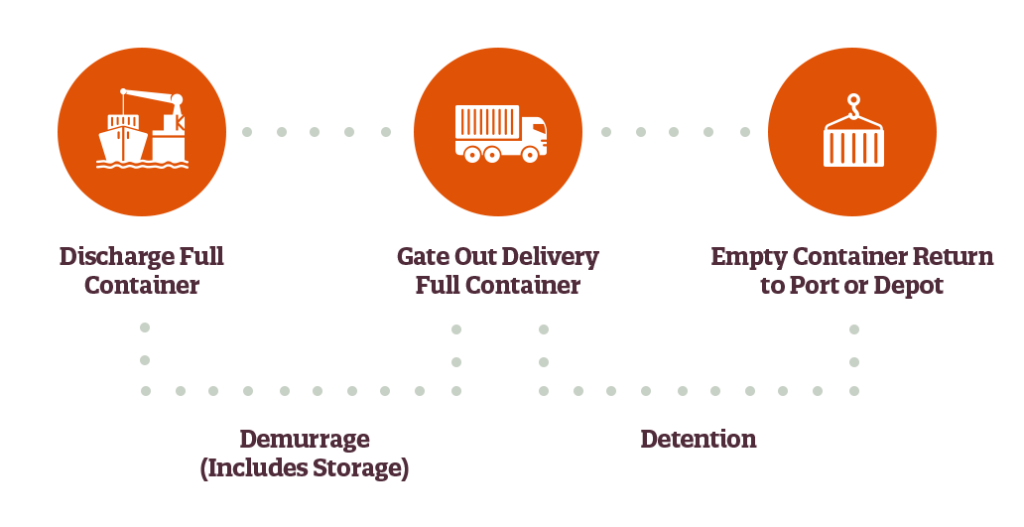Detention and demurrage charges can be a bit of a headache in the shipping world. They’re basically fees that are charged when there’s a delay in returning shipping containers or using them beyond the agreed free time. These charges can quickly add up, and they can have a big impact on your shipping budget.

Detention Charges
Detention charges occur when you keep a container outside the port or terminal beyond the allowed free days. Imagine you borrowed a library book and kept it past the due date; detention charges are like those late fees. These charges can vary depending on the shipping line and the location, so it’s important to know the rules.
Demurrage Charges
Demurrage charges, on the other hand, are incurred when your container stays at the port or terminal for longer than the free time allowed. Think of it as parking your car in a paid lot and forgetting to move it before the meter runs out. Again, these charges differ by shipping line and location, and they can pile up if you’re not careful.
How Are Detention and Demurrage Charges Calculated?
Understanding how detention and demurrage charges are calculated is essential for managing your shipping costs effectively. Here’s a breakdown of the calculation process:
- Free Time Allowed: Each shipping line and terminal has a specified number of free days for both detention and demurrage. This is the period during which you can use the container without incurring any charges. Familiarize yourself with these terms to avoid unnecessary fees.
- Daily Rate: Once the free time expires, the shipping line will charge a daily rate for each additional day the container is held. This rate can vary significantly based on the shipping line, type of container, and location. It’s crucial to check the specific rates applicable to your shipment.
- Additional Fees: Be aware that some shipping lines may impose additional fees for specific circumstances, such as administrative fees or penalties for excessive delays. Always read the fine print in your shipping contract.
Calculation Method:
Detention Charges: Calculated based on the number of days the container is kept outside the port or terminal beyond the free time, multiplied by the daily rate.
Demurrage Charges: Calculated similarly, but based on the number of days the container remains at the port or terminal beyond the free time.
Example of Demurrage Charges Calculation:
- Free Time Allowed: Let’s say the shipping line allows 5 free days for demurrage.
- Daily Rate: The daily demurrage rate is $19,000.
- Days Over Free Time: If the container stays at the port for 10 days, that means it has exceeded the free time by 5 days.
Calculation:
- Days Over Free Time: 10 days (total) – 5 days (free) = 5 days
- Total Demurrage Charges: 5 days × $19,000 (daily rate) = $95,500
In this example, the total demurrage charges incurred would be $95,500. This illustrates the importance of managing container returns to avoid unnecessary costs.
What Causes Detention and Demurrage Charges to Arise?
Understanding the root causes of detention and demurrage charges is essential for effective management. Here are some common factors that can lead to these fees:
- Inefficient Logistics Planning: Poor planning in logistics can result in delays in container pickup and return. If your team does not coordinate effectively with shipping lines and terminals, it can lead to extended use of containers beyond the free time.
- Port Congestion: High traffic at ports can cause delays in unloading and returning containers. When ports are congested, it may take longer than expected to get your containers back, leading to demurrage charges.
- Customs Delays: If there are issues with customs clearance, it can hold up the release of containers. Delays in documentation or inspections can result in containers being stuck at the port longer than anticipated.
- Equipment Availability: Sometimes, the lack of available equipment, such as trucks or cranes, can delay the return of containers. If your logistics provider does not have the necessary resources, it can lead to extended detention times.
- Weather Conditions: Adverse weather can disrupt shipping schedules and cause delays in both pickup and return of containers. Storms, heavy rains, or other natural events can impact port operations and logistics.
- Miscommunication: Lack of clear communication between all parties involved in the shipping process can lead to misunderstandings and delays. Ensuring everyone is on the same page is crucial to avoid unnecessary charges.
By being aware of these factors, businesses can take proactive steps to mitigate the risk of incurring detention and demurrage charges, ultimately saving money and improving operational efficiency.
Why Do These Charges Matter?
Detention and demurrage charges might seem like a small nuisance, but they can have big implications for your business. Here’s why they matter:
- Financial Impact
First and foremost, these charges can become a significant financial burden. If you don’t manage your container returns efficiently, you could end up paying more than you bargained for. This can affect your bottom line and eat into your profits.
- Operational Delays
Delays in returning containers can lead to operational hiccups. If containers aren’t returned on time, it can disrupt the flow of goods and create bottlenecks in your supply chain. This can lead to frustrated customers and missed deadlines.
- Geopolitical Factors
While we’re at it, let’s not forget about the geopolitical factors that can influence these charges. Political tensions, trade wars, and changes in regulations can all impact shipping schedules and lead to unexpected delays. It’s crucial to stay informed about these developments to anticipate potential issues.
- How to Avoid Detention and Demurrage Charges
Now that we know why these charges matter, let’s talk about how to avoid them. Here are some practical tips to keep those fees at bay:
Tips for Avoid Detention and Demurrage
Plan Ahead
Planning is key. Coordinate with your logistics partners to ensure that containers are picked up and returned within the free time allowed. Good communication can prevent unnecessary delays.
Stay Informed
Keep an eye on shipping schedules and any potential disruptions. Being aware of port congestion, labor strikes, or adverse weather conditions can help you adjust your plans accordingly.
Use Technology
Leverage technology to track your containers and get real-time updates. Many shipping lines offer online tools and apps that can help you monitor container movements and avoid surprises.
Build Strong Relationships
Having a good relationship with your shipping line and terminal operators can make a big difference. They can offer valuable insights and help you navigate tricky situations.



